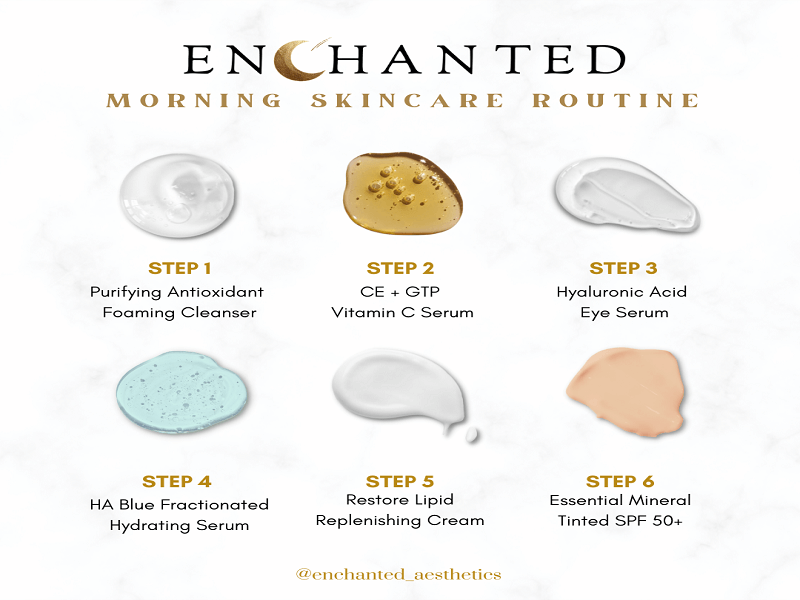The answer to “What step is hyaluronic acid in skin care?” is typically after cleansing and toning, but before heavier creams and oils. This allows the hyaluronic acid to draw moisture into the skin effectively. Now, let’s delve deeper into how to maximize the benefits of this hydrating hero and precisely how to incorporate hyaluronic acid into your skincare routine.

Image Source: enchantedmedicalaesthetics.com
Grasping Hyaluronic Acid and Its Role
Hyaluronic acid (HA) is a naturally occurring substance in the skin that helps retain moisture. Think of it like a sponge that can hold up to 1000 times its weight in water. This ability makes it a fantastic ingredient for keeping skin hydrated, plump, and youthful-looking. However, HA is a large molecule. For topical application to be effective, it’s often hydrolyzed (broken down into smaller pieces) to penetrate the skin more easily. The concentration can also impact the results.
Why Hyaluronic Acid Needs Water
Here’s a crucial piece of information: hyaluronic acid needs water to work. It draws moisture from its surroundings. If you live in a humid climate, that’s great! But if you’re in a dry environment, it can pull moisture from the deeper layers of your skin, potentially leading to dehydration. That’s why it’s essential to know when to apply hyaluronic acid and how to layer it properly.
The Ideal Hyaluronic Acid Order Skincare
So, what is the best hyaluronic acid order skincare? Think of layering skincare like building a house. You need a strong foundation (cleanser) before adding the walls (serums) and roof (moisturizer).
Here’s a general guideline for hyaluronic acid routine placement:
- Cleanse: Start with a gentle cleanser to remove dirt, oil, and makeup.
- Tone (Optional): A hydrating toner can prep the skin.
- Serum (Hyaluronic Acid): Apply your hyaluronic acid serum to damp skin.
- Other Serums (Optional): Apply thinner serums before thicker ones.
- Moisturizer: Seal in the hydration with a moisturizer.
- Sunscreen (Daytime): Protect your skin from the sun.
- Facial Oil (Optional): Use as the last step to lock in moisture.
A Detailed Hyaluronic Acid Skincare Sequence
Let’s break down each step to better comprehend the best hyaluronic acid application order.
Step 1: Cleansing
Use a cleanser that suits your skin type.
- Oily Skin: Gel or foam cleansers
- Dry Skin: Creamy or oil-based cleansers
- Sensitive Skin: Gentle, fragrance-free cleansers
Step 2: Toning (Optional)
Toners can balance your skin’s pH and provide an extra layer of hydration. Choose alcohol-free toners to avoid drying out your skin. A hydrating toner can make your HA work even better.
Step 3: Hyaluronic Acid Serum Application
This is where the magic happens. But there’s a trick to making the hyaluronic acid work optimally:
- Damp Skin is Key: Apply the serum to damp skin. You can achieve this by leaving your skin slightly wet after cleansing or using a facial mist.
- Amount: Use a pea-sized amount for your entire face.
- Application Technique: Gently pat the serum into your skin rather than rubbing.
Step 4: Other Serums
If you use other serums, like vitamin C or niacinamide, apply them based on consistency. Thinner serums go on before thicker ones. For instance, a water-based serum should be applied before an oil-based one. Allow each serum to absorb fully before applying the next.
Step 5: Moisturizing
Moisturizer is crucial to seal in the hydration provided by the hyaluronic acid. It creates a barrier that prevents water loss. Choose a moisturizer that suits your skin type:
- Oily Skin: Lightweight, gel-based moisturizers
- Dry Skin: Rich, cream-based moisturizers
- Combination Skin: A balanced, lotion-based moisturizer
Step 6: Sunscreen (Daytime)
Sunscreen is non-negotiable, especially when using active ingredients like hyaluronic acid. It protects your skin from sun damage and premature aging. Apply a broad-spectrum sunscreen with an SPF of 30 or higher every morning.
Step 7: Facial Oil (Optional)
If you use a facial oil, apply it as the last step in your routine. Oil can penetrate moisturizer, but moisturizer can’t penetrate oil. The oil helps to lock in all the previous layers of hydration.
When to Apply Hyaluronic Acid: Morning or Night?
The best time to use hyaluronic acid is both morning and night. You can incorporate it into both your AM and PM skincare routines.
- Morning Routine: Provides hydration throughout the day and preps your skin for makeup.
- Night Routine: Helps repair and hydrate your skin while you sleep.
Hyaluronic Acid Serum Layering: Tips & Tricks
How you layer hyaluronic acid with other products significantly impacts its effectiveness.
Layering with Actives
Be mindful when layering HA with other active ingredients.
- Vitamin C: HA can be layered with Vitamin C to help with moisture retention.
- Retinoids: Can be layered, but monitor for irritation. Apply HA before or after the retinoid, depending on your skin’s tolerance. Some prefer to apply HA before to create a buffer, while others apply it after to soothe any potential irritation.
- AHAs/BHAs: Apply HA after AHAs/BHAs. These exfoliants can be drying, so following up with HA helps replenish moisture.
Hyaluronic Acid Before or After? Addressing Common Concerns
A common question is “hyaluronic acid before or after?” Here’s a quick guide:
- Hyaluronic acid before or after moisturizer? Before. This allows the HA to draw moisture into the skin, and the moisturizer seals it in.
- Hyaluronic acid before or after toner? After. Toner preps the skin, making it more receptive to the HA.
- Hyaluronic acid before or after retinol? Experiment to see what your skin tolerates. As explained above, apply HA before retinol as a buffer or after to calm irritation.
Optimizing Hyaluronic Acid Effectiveness: Key Considerations
Beyond the right hyaluronic acid skincare sequence, consider these factors to maximize the benefits:
- Climate: In dry climates, pair HA with a humectant like glycerin and a moisturizer to prevent it from drawing moisture from your skin.
- Product Formulation: Look for HA serums that contain different molecular weights of hyaluronic acid. Smaller molecules penetrate deeper, while larger molecules hydrate the surface.
- Skin Type: All skin types can benefit from HA, but those with dry or dehydrated skin will see the most dramatic results.
- Consistency is Key: Use HA consistently, both morning and night, for best results.
The Importance of Hydration: Internal and External
Remember, topical application of HA is just one piece of the puzzle. Hydration from the inside out is equally important.
- Drink Plenty of Water: Aim for at least eight glasses of water a day.
- Eat Hydrating Foods: Incorporate fruits and vegetables with high water content, such as watermelon, cucumber, and spinach.
- Avoid Dehydrating Beverages: Limit your intake of alcohol and caffeinated drinks.
Troubleshooting Hyaluronic Acid
Sometimes, despite following all the right steps, you might experience unexpected results. Here are some common issues and how to address them:
- Dryness or Tightness: This could mean the HA is drawing moisture from your skin. Ensure you’re applying it to damp skin and sealing it in with a moisturizer.
- Irritation: Some HA serums contain other ingredients that might irritate your skin. Choose fragrance-free and alcohol-free formulas.
- No Visible Results: It might take several weeks of consistent use to see noticeable improvements. Also, ensure the HA serum you’re using is of good quality.
Incorporating Hyaluronic Acid into Skincare Based on Skin Type
Different skin types may need different strategies when incorporating hyaluronic acid into their skincare routines.
Dry Skin: Individuals with dry skin should focus on layering hyaluronic acid with rich moisturizers and occlusive products to lock in hydration. Applying HA serum on damp skin after a hydrating toner, followed by a thick cream, can significantly improve moisture levels.
Oily Skin: Those with oily skin can still benefit from hyaluronic acid, but they should opt for lightweight, oil-free formulations. A gel-based HA serum followed by a light moisturizer will provide hydration without clogging pores.
Combination Skin: People with combination skin can use hyaluronic acid to balance hydration levels. Apply the serum to the entire face, focusing on drier areas. Follow with a moisturizer suitable for combination skin, which typically balances hydration without causing excess oiliness.
Sensitive Skin: Individuals with sensitive skin should choose hyaluronic acid serums with minimal ingredients to avoid irritation. Always patch-test new products. Combining HA with soothing ingredients like aloe vera or chamomile can also help calm the skin.
Fathoming Hyaluronic Acid Variations and Concentrations
Hyaluronic acid comes in different molecular weights, and the concentration in skincare products can vary.
- Molecular Weight: High molecular weight HA stays on the skin’s surface, providing immediate hydration and reducing water loss. Low molecular weight HA penetrates deeper, offering longer-term hydration.
- Concentration: Most HA serums contain between 1% and 2% hyaluronic acid. Higher concentrations aren’t necessarily better and can sometimes lead to stickiness or irritation.
| Feature | High Molecular Weight HA | Low Molecular Weight HA |
|---|---|---|
| Penetration | Surface-level | Deeper |
| Hydration | Immediate | Long-term |
| Best For | Dry, dehydrated skin | All skin types |
FAQ: Frequently Asked Questions
- Can I use hyaluronic acid every day? Yes, it’s safe to use HA daily, both morning and night.
- Can hyaluronic acid cause breakouts? It’s unlikely, but some formulations may contain other ingredients that can clog pores.
- What are the side effects of hyaluronic acid? Side effects are rare but can include mild irritation or allergic reactions.
- How long does it take to see results from hyaluronic acid? You may notice immediate hydration, but it can take several weeks to see significant improvements in skin plumpness and elasticity.
- Can I use hyaluronic acid with other active ingredients? Yes, but be mindful of potential interactions.
- Who is best suited for hyaluronic acid? Almost everyone can benefit from hyaluronic acid, especially those with dry or dehydrated skin.
- What is the best way to store hyaluronic acid serum? Store in a cool, dark place, away from direct sunlight and heat, to maintain its stability.
By following these guidelines and understanding the science behind hyaluronic acid, you can effectively incorporate it into your skincare routine and achieve hydrated, healthy, and radiant skin.

I’m Carrie Kelly, the creator behind Gotham Beauty Lounge. Beauty is my passion, and I’ve made it my mission to bring you all the latest trends, expert tips, and honest reviews to help you elevate your beauty game. With a love for all things bold, edgy, and elegant, I believe makeup is an art form, and skincare is self-care. On my blog, I share my personal experiences, favorite products, and advice for embracing your unique beauty. Join me on this exciting journey to feel confident, empowered, and, most importantly, to always look and feel your best!
